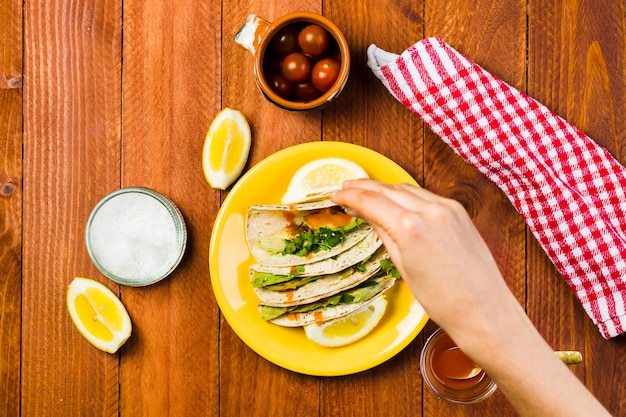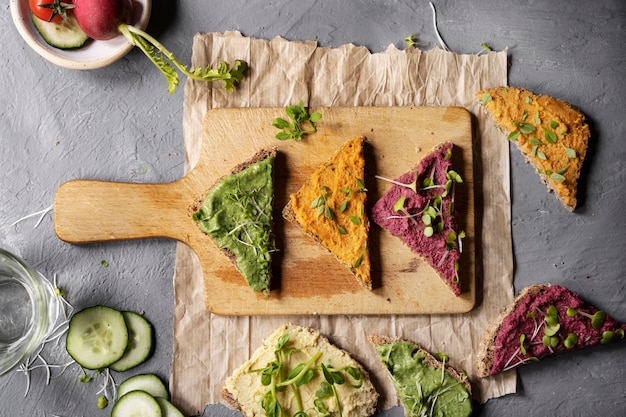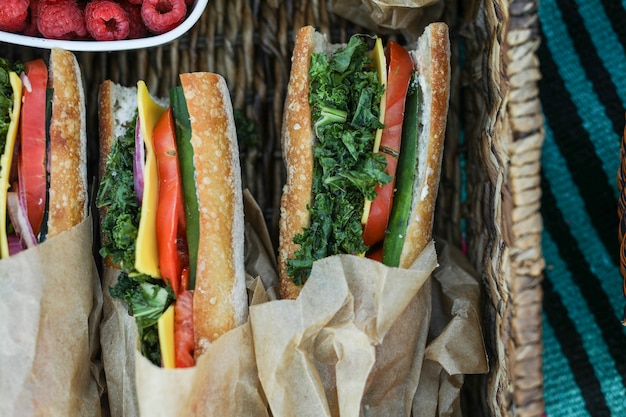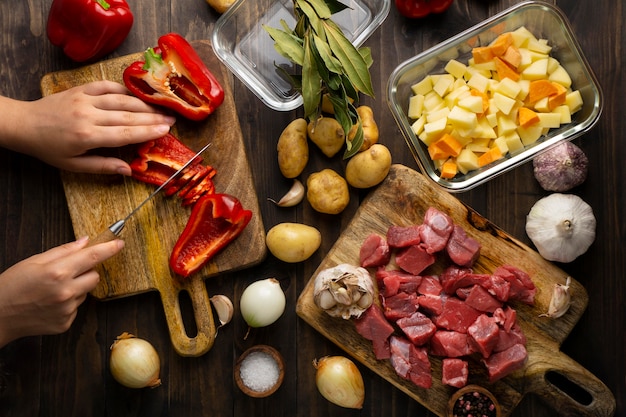Panini Sandwich Recipes: The Ultimate Guide to Crispy, Delicious Grilled Sandwiches
Ah, panini. These little gems, with their perfectly toasted bread and oozing fillings, have been a constant source of comfort and culinary delight in my life for as long as I can remember. They're always a winner, whether it's a quick lunch on the go, a satisfying dinner with friends, or a weekend treat. Over the years, I've experimented with countless combinations, from classic Italian flavours to adventurous gourmet creations. And let me tell you, there's a panini out there for everyone. So grab a loaf of crusty bread, some tasty toppings, and let's embark on this panini adventure together!
(Part 1) The Panini Primer: Understanding the Basics

Before we dive headfirst into the recipes, let's get the fundamentals sorted out. A panini isn't just any old grilled sandwich. It's a culinary masterpiece with a distinct character – a crispy, golden-brown exterior and a molten-hot, flavourful interior. It's all about that perfect balance of textures and tastes, and a few key tools and techniques can elevate your panini game to a whole new level.
The Equipment: Your Panini Press and Beyond
The hero of the panini story is, of course, the panini press. It's the key to achieving that signature, perfectly flat, crispy exterior. Mine's been a trusty companion for years, a real workhorse in the kitchen. Now, if you're on a tight budget, a cast-iron skillet will do the trick, and you can even use a regular griddle pan or even a heavy-bottomed frying pan. The main aim is to apply even pressure to the sandwich, ensuring that both sides are toasted evenly.
But beyond the press, you'll need some trusty sidekicks. A good set of kitchen knives is essential for slicing and dicing ingredients, and a sturdy chopping board will provide a stable surface for prepping. A spatula will come in handy for flipping and manoeuvring your panini, and a set of tongs will help you transfer them to and from the press. You'll also want to have a couple of clean tea towels on hand to mop up any spills and keep your work surface tidy.
The Bread: The Foundation of Your Panini
Choosing the right bread is crucial. It needs to be substantial enough to hold its own against the fillings, but also soft enough to be enjoyable to eat. A classic ciabatta or sourdough is my go-to, but focaccia, baguette, or even multigrain bread can work wonders. You can even get creative with rustic rolls or even brioche, but steer clear of anything too fluffy or flimsy. And if you're looking for a fun twist, try toasted english muffins or even flatbreads.
Here's a tip: lightly brush your chosen bread with olive oil or melted butter before grilling. This will help create a crispy crust and prevent sticking.
The Fillings: Unleash Your Creativity
This is where the fun really begins! The possibilities for panini fillings are truly endless. But before we get carried away, remember: balance is key. You need a combination of textures and tastes that work together harmoniously. A classic Italian panini might feature ham, salami, and provolone cheese, with a drizzle of olive oil and a sprinkle of oregano. But why stop there? Experiment with different meats, cheeses, vegetables, sauces, and even spreads. The possibilities are endless.
The Art of Assembling: Layers and Textures
There's a right way and a wrong way to assemble a panini. You want a balance of ingredients and textures, and it's best to build it layer by layer. Start with a base of cheese, then add your meats, vegetables, and sauces. Think about how each element will interact with the others, and don't be afraid to get creative with your layering. The key is to create a sandwich that's both flavorful and visually appealing. Avoid overloading your panini – it's better to err on the side of less is more. If you're using a lot of wet ingredients, like tomatoes or peppers, consider placing a few lettuce leaves on the bread first to absorb excess moisture.
(Part 2) Panini Essentials: Mastering the Fundamentals

Now that we have a good grasp of the basics, let's move on to some essential tips and tricks that will help you elevate your panini game from good to great.
The Art of Toasting: Achieving the Perfect Crisp
Toasting the bread is the foundation of a good panini. You want it to be golden brown and slightly crispy on the outside, while remaining soft and yielding on the inside. For a panini press, start by preheating it to medium-high heat, then place your assembled sandwich in the press and close the lid. Cook for 2-3 minutes, flipping halfway through to ensure even cooking. Keep an eye on the colour of the bread, and adjust cooking time accordingly.
If you're using a skillet, heat it over medium heat and add a tablespoon of olive oil. Place your sandwich in the skillet and cook for 2-3 minutes per side, pressing down lightly with a spatula to achieve that characteristic panini flatness. Listen for that satisfying sizzle, and don't be afraid to give your sandwich a gentle push to ensure even browning.
Melting Magic: Choosing the Right Cheese
Cheese is a crucial ingredient in any panini. It adds richness, creaminess, and a touch of saltiness. But not all cheeses are created equal. Some melt beautifully, while others can become tough and rubbery. For a classic panini, mozzarella is always a good choice, but provolone, fontina, and even cheddar can work well. Go for slices or chunks that melt readily. Experiment with different cheeses to discover your favourites.
To ensure your cheese melts evenly and doesn't burn, try grilling your panini on a lower heat setting or for a shorter amount of time. You can also use a cheese grater to create finer shreds for faster and more even melting.
The Sauce Factor: Enhancing Flavours
Sauces can add a whole new dimension of flavour to your panini. A simple drizzle of olive oil or balsamic vinegar can be all it takes to elevate the taste. For a bolder flavour, consider adding pesto, marinara sauce, or even a dollop of mustard. Experiment with different sauces to see what complements your chosen fillings.
If you're using a sauce that's prone to making your panini soggy, try spreading it on the bread instead of directly on the fillings. This will help to prevent the bread from becoming waterlogged.
The Garnish Game: Finishing Touches
A final sprinkle of fresh herbs or a drizzle of balsamic glaze can add a touch of elegance to your panini. You can also get creative with sliced tomatoes, onions, or even a sprinkle of crushed pepper. The finishing touches are what make your panini truly stand out.
Here's a tip: Instead of adding your garnish directly to the panini, try placing it on a plate alongside the sandwich. This will keep your panini from becoming soggy and allows your guests to add their own finishing touches.
(Part 3) Panini Adventures: Exploring the World of Flavours

Now that you have a solid understanding of the fundamentals, let's dive into some delicious panini recipes. From classic Italian flavours to gourmet combinations, there's a panini out there for every palate. Get ready to embark on a culinary adventure, where crispy bread, oozing cheese, and delicious fillings come together to create flavourful masterpieces.
The Classic Italian Panini: A Taste of Italy
This is a simple but delicious recipe that captures the essence of Italian cuisine. You'll need:
- 1 ciabatta roll, sliced in half
- 2 slices provolone cheese
- 2 slices cooked ham
- 2 slices salami
- 1 tablespoon olive oil
- 1 teaspoon dried oregano
Instructions:
- Spread olive oil on both sides of the ciabatta roll.
- Layer the provolone cheese, ham, and salami on one half of the roll.
- Sprinkle with dried oregano.
- Close the panini and cook in a panini press or skillet for 2-3 minutes per side, or until the bread is golden brown and the cheese is melted.
- Serve immediately.
For an extra touch of authenticity, try adding a few slices of marinated artichoke hearts or a sprinkle of roasted red pepper flakes.
The Caprese Panini: A Fresh and Flavourful Option
This light and refreshing panini is perfect for a summer lunch or dinner. You'll need:
- 1 baguette, sliced in half
- 4 slices fresh mozzarella
- 2 large slices tomato
- 1 tablespoon balsamic glaze
- 1 tablespoon olive oil
- Fresh basil leaves, for garnish
Instructions:
- Spread olive oil on both sides of the baguette.
- Layer the mozzarella, tomato slices, and balsamic glaze on one half of the baguette.
- Close the panini and cook in a panini press or skillet for 2-3 minutes per side, or until the bread is golden brown and the cheese is melted.
- Garnish with fresh basil leaves and serve immediately.
To prevent the tomato from making your panini soggy, consider grilling it for a few minutes before assembling the sandwich. You can also add a few fresh spinach leaves for a boost of nutrients and flavour.
The Spicy Chicken Panini: A Kick of Heat
If you like a little heat, this panini will rock your world. You'll need:
- 1 ciabatta roll, sliced in half
- 2 slices cheddar cheese
- 4 ounces grilled chicken breast, sliced
- 1 tablespoon jalape??o peppers, sliced
- 1 tablespoon salsa
- 1 tablespoon sour cream
Instructions:
- Spread sour cream on both sides of the ciabatta roll.
- Layer the cheddar cheese, chicken, jalape??o peppers, and salsa on one half of the roll.
- Close the panini and cook in a panini press or skillet for 2-3 minutes per side, or until the bread is golden brown and the cheese is melted.
- Serve immediately.
For a spicier kick, use a spicier salsa or add a pinch of cayenne pepper to the filling.
The Gourmet Mushroom Panini: A Taste of Luxury
This panini is all about earthy flavours and rich textures. You'll need:
- 1 focaccia bread, sliced in half
- 4 ounces portobello mushrooms, sliced
- 2 slices fontina cheese
- 1 tablespoon truffle oil
- 1 tablespoon balsamic glaze
- Fresh thyme leaves, for garnish
Instructions:
- Spread truffle oil on both sides of the focaccia bread.
- Layer the portobello mushrooms, fontina cheese, and balsamic glaze on one half of the bread.
- Close the panini and cook in a panini press or skillet for 2-3 minutes per side, or until the bread is golden brown and the cheese is melted.
- Garnish with fresh thyme leaves and serve immediately.
To enhance the earthy flavours, try sautéing the mushrooms with a little garlic and onion before adding them to the panini. You can also substitute the fontina cheese with brie or goat cheese for a different flavour profile.
The Veggie Delight Panini: A Healthy and Hearty Option
This panini is packed with fresh vegetables and flavours. You'll need:
- 1 multigrain bread, sliced in half
- 2 slices provolone cheese
- 1/2 cup roasted red peppers, sliced
- 1/4 cup spinach leaves
- 1 tablespoon pesto
Instructions:
- Spread pesto on both sides of the multigrain bread.
- Layer the provolone cheese, roasted red peppers, and spinach leaves on one half of the bread.
- Close the panini and cook in a panini press or skillet for 2-3 minutes per side, or until the bread is golden brown and the cheese is melted.
- Serve immediately.
To add extra flavour and texture, try grilling some zucchini or eggplant slices before adding them to the panini. You can also substitute the provolone cheese with mozzarella or even a vegan cheese alternative.
(Part 4) Panini Perfection: Elevating Your Sandwich Game
Now that you've got some delicious recipes under your belt, let's explore some techniques and tricks to really elevate your panini game. From mastering the art of grilling to adding exciting flavour profiles, let's make your sandwiches truly unforgettable.
Grilling Techniques: Achieving that Crispy Edge
The key to a perfect panini lies in the grilling. You want that golden-brown crust, a touch of char, and a satisfying crunch. Here's how to achieve that crispy perfection:
- Preheat: Make sure your panini press or skillet is piping hot before you add the sandwich. This ensures even browning and a crispy texture.
- Butter Up: A thin layer of butter or oil on both sides of the bread will help create a crisp crust and prevent sticking.
- Even Pressure: Ensure even pressure on the sandwich, whether using a press or a skillet. This ensures that both sides cook evenly and the filling melts properly.
- Flip It: Flip the panini halfway through cooking to ensure even browning on both sides.
- Don't Overcook: Keep a close eye on the bread. You want it golden brown and slightly crispy, but not burnt. You'll know it's ready when it reaches a nice golden hue and has a slightly crisp texture.
For an extra-crispy crust, try grilling your panini for a few minutes longer than usual. Just be careful not to burn the bread!
The Power of Flavour: Elevating Your Fillings
Let's face it, the fillings are the heart and soul of a panini. Here's how to elevate them to the next level:
- Seasoned Meats: Marinate your meats before grilling or cooking for an added punch of flavour. A simple marinade of olive oil, lemon juice, garlic, and herbs can make a world of difference.
- caramelized onions: These add a sweet and savory flavour to any panini. Sauté them in butter or olive oil until they are soft and golden brown.
- Roasted Vegetables: Roasted peppers, zucchini, or eggplant add a depth of flavour and a delightful texture.
- Bold Sauces: Experiment with sauces like pesto, chimichurri, or even spicy mayo to add a burst of flavour.
- Creative Combinations: Don't be afraid to mix and match ingredients and create your own unique flavour profiles. Think about complementary flavour pairings, like sweet and savoury, or spicy and tangy.
(Part 5) The Panini Journey: Beyond the Basics
We've explored the fundamentals and explored some delicious recipes. Now, let's venture beyond the basics and discover some creative variations and innovative ideas that will elevate your panini game.
Beyond the Press: Alternative Grilling Methods
While a panini press is a fantastic tool, it's not the only way to achieve that crispy, golden-brown crust. Here are some alternative grilling methods to explore:
- cast iron skillet: A heavy-bottomed cast-iron skillet can deliver similar results to a panini press. Simply heat the skillet over medium heat and cook the panini for 2-3 minutes per side, pressing down gently with a spatula to create that signature panini flatness.
- Griddle Pan: A flat griddle pan is another great option for grilling panini. Heat it over medium heat and cook the panini for 2-3 minutes per side, flipping halfway through.
- Oven Broiler: For a quick and easy option, you can use your oven broiler. Place the assembled panini on a baking sheet and broil for 2-3 minutes, or until the bread is golden brown and the cheese is melted.
Just remember to be careful when using the oven broiler, as it can get very hot. You'll want to keep a close eye on your panini to prevent it from burning.
Panini Variations: Exploring Different Styles
Panini are incredibly versatile and lend themselves to various culinary styles. Here are some exciting variations to consider:
- Grilled Cheese Panini: A simple yet satisfying classic, the grilled cheese panini is a comforting and nostalgic treat. Use your favourite bread, cheese, and even add some butter or mayonnaise to the bread for extra richness.
- Cuban Panini: A flavourful and hearty sandwich with a distinctly Cuban flair. It typically features roasted pork, ham, Swiss cheese, pickles, and mustard. The key to a good Cuban panini is to press the sandwich until it's flat and crispy, ensuring that all the fillings are melded together.
- Falafel Panini: A vegetarian delight, the falafel panini combines crispy falafel patties with hummus, tahini, and fresh vegetables. It's a delicious and satisfying alternative for those looking for a meat-free option.
- Thai Panini: A fusion of Thai flavours and a panini structure. This might feature grilled chicken or tofu, peanut sauce, and fresh mango or pineapple. The sweet and spicy notes of the peanut sauce and the tropical sweetness of the mango or pineapple make for a truly unique and delicious panini.
Panini Inspiration: Finding New Ideas
The world of panini is vast and constantly evolving. Here are some places to find new inspiration:
- Cooking Blogs and Websites: Numerous food blogs and websites are dedicated to panini recipes and variations.
- Recipe Books: Explore cookbooks dedicated to sandwiches, or even those focusing on Italian cuisine.
- Restaurant Menus: Take inspiration from local restaurants that specialize in panini.
- Social Media: Instagram and Pinterest are brimming with beautiful photos and creative panini ideas.
(Part 6) Panini Pairings: The Perfect Accompaniments
A delicious panini deserves a worthy sidekick. Here are some perfect pairings to elevate your meal:
Salads: A Light and Refreshing Side
A simple green salad with a vinaigrette dressing provides a refreshing counterpoint to the richness of a panini. Consider adding some fresh tomatoes, cucumbers, or even a few grilled vegetables for extra flavour.
Soup: A Warm and Hearty Contrast
A bowl of warm soup is a perfect pairing for a panini, especially during colder months. A light tomato soup, a creamy mushroom soup, or even a hearty lentil soup can complement your sandwich perfectly.
Sides: Adding Variety to Your Meal
Consider adding some sides to round out your meal. Here are some ideas:
- french fries: Crispy, golden-brown french fries are a classic pairing for any sandwich.
- Onion Rings: These offer a sweet and savoury counterpoint to the flavours of a panini.
- potato salad: A creamy and comforting side dish that pairs well with many panini flavours.
If you're feeling adventurous, try serving your panini with a side of roasted vegetables, like asparagus or broccoli.
(Part 7) Panini Beyond the Kitchen: Taking Your Sandwich on the Go
Panini are perfect for on-the-go lunches or picnics. Here's how to pack them for the perfect portable meal:
Packing for a Picnic: Keeping Your Panini Fresh
Here are a few tips for keeping your panini fresh and delicious for your picnic:
- Wrap it Up: Use parchment paper or aluminum foil to wrap your panini, preventing it from becoming soggy.
- Pack it Cool: Bring a cooler bag to keep your panini cold, especially if you're packing cheese or perishable fillings.
- Assemble at the Destination: If you're concerned about the fillings getting soggy, assemble your panini just before you eat it.
To prevent your panini from getting squished, consider packing it in a sturdy lunchbox or container.
Panini for the Lunchbox: A Hearty and Delicious Option
Panini are a great option for packing lunch. Here are some tips for a successful lunchbox panini:
- Choose a Sturdy Bread: Opt for a bread that will hold its shape well, like a ciabatta or sourdough roll.
- Avoid Soggy Fillings: Choose fillings that are not prone to getting soggy, such as roasted vegetables, grilled meats, or cheeses that melt easily.
- Pack Separately: For a lunchbox panini, pack the bread and fillings separately to prevent them from getting soggy. Combine them just before eating.
To add some extra flavour to your lunchbox panini, try grilling the bread before assembling the sandwich. This will give it a nice crispy texture that will hold up well in the lunchbox.
(Part 8) The Panini Legacy: The Story Behind the Sandwich
The panini, a humble sandwich, has a rich history and a fascinating story. Let's delve into its origins and discover what makes this culinary creation so beloved around the world.
From Italy to the World: The Panini's Global Journey
The origins of the panini can be traced back to Italy, where it's believed to have emerged as a simple street food. The name "panini" comes from the Italian word "panino," which means "small bread." In traditional Italian cuisine, it was a simple sandwich, often made with crusty bread and basic fillings. But over the years, it evolved into a more complex and sophisticated culinary creation, with chefs and home cooks experimenting with new and innovative ingredients and flavours.
The panini's journey began with humble beginnings, but it quickly gained popularity for its simple yet delicious flavour. It was a sandwich that could be enjoyed by anyone, anywhere, anytime.
The Rise of the Panini Press: A Technological Twist
The development of the panini press was a significant moment in the panini's journey. This special appliance, with its flat grilling surface and heavy lid, allowed for the perfect toasting and pressing of panini, creating that signature crispy exterior and perfectly melted interior. The panini press became synonymous with the panini itself, transforming it from a simple street food into a beloved culinary staple.
The panini press became more than just a tool – it became a symbol of the panini itself. It represented the evolution of the sandwich from a humble street food into a gourmet delight.
The Panini's Cultural Impact: A Culinary Symbol
The panini has become more than just a sandwich. It has evolved into a culinary symbol, representing both the simplicity and the sophistication of Italian cuisine. It's a testament to the power of a few simple ingredients, brought together in perfect harmony, to create a truly delicious and satisfying experience. Whether enjoyed at a bustling Italian cafe or a cozy kitchen, the panini remains a popular choice for people of all ages and backgrounds. It's a sandwich that speaks to our collective love of comfort food and a reminder that sometimes, the simplest things are the most enjoyable.
The panini has become a global culinary icon, enjoyed by people from all walks of life. It's a testament to the power of simple food to bring people together and create a sense of shared enjoyment.
FAQs: Panini Queries Answered
You've got questions, and I've got answers. Here are some of the most common inquiries about panini, answered in detail:
1. What is the best bread for a panini?
While there's no one-size-fits-all answer, ciabatta, sourdough, focaccia, baguette, or even multigrain bread are excellent choices. You want a bread that's substantial enough to hold its own against the fillings, but also soft enough to be enjoyable to eat.
Ultimately, the best bread for a panini is the one that you enjoy the most! Experiment with different types of bread to find your favourite.
2. Can I make a panini without a panini press?
Absolutely! You can use a cast-iron skillet, a griddle pan, or even a heavy-bottomed frying pan. The key is to apply even pressure to the sandwich, ensuring that both sides are toasted evenly.
If you don't have a panini press, don't let that stop you from enjoying delicious panini. Get creative and use what you have on hand.
3. How do I prevent my panini from getting soggy?
Use fillings that are not prone to getting soggy, like roasted vegetables, grilled meats, or cheeses that melt easily. You can also pack the bread and fillings separately for a lunchbox panini and combine them just before eating.
If you're using a lot of wet ingredients, consider grilling them for a few minutes before adding them to the panini. This will help to remove some of the moisture and prevent your sandwich from getting soggy.
4. What are some creative panini combinations?
The possibilities are endless! Consider combining flavours from different cuisines, like a Thai panini with grilled chicken, peanut sauce, and fresh mango or pineapple, or a falafel panini with crispy falafel patties, hummus, tahini, and fresh vegetables.
Don't be afraid to experiment and create your own unique panini combinations. The only limit is your imagination!
5. How do I store leftover panini?
It's best to store leftovers in an airtight container in the refrigerator for up to 2 days. You can reheat them in a panini press, skillet, or oven broiler until the bread is toasted and the filling is warm.
If you're planning to reheat your panini, consider using a sturdy bread like ciabatta or sourdough, which will hold up better to reheating.
Everyone is watching

Perfect Rice Every Time: The Ultimate Guide to Cooking Rice
Cooking TipsAs a self-proclaimed foodie, I've always been a bit obsessed with rice. It's the foundation of countless cuisi...

The Ultimate Guide to Cooking Asparagus: Tips, Techniques, and Recipes
Cooking TipsAsparagus. The mere mention of this spring delicacy conjures up images of vibrant green spears, crisp and burs...

Ultimate Guide to Cooking the Perfect Thanksgiving Turkey
Cooking TipsThanksgiving. Just the word conjures up images of overflowing tables laden with delicious food, the scent of r...

Can You Cook Spaghetti with Gasoline? (The Shocking Truth)
Cooking TipsWe've all seen those crazy internet trends. You know, the ones that make you wonder, "Did someone actually try...

Chorizo and Eggs Recipe: The Ultimate Guide
Cooking TipsRight, let’s talk about chorizo and eggs. You know, that classic Spanish dish that's always a winner. It's th...
